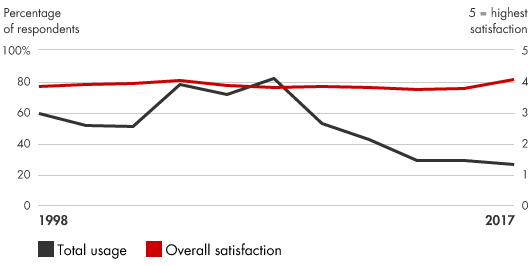Management Tools
Customer Segmentation is the subdivision of a market into discrete customer groups that share similar characteristics. Customer Segmentation can be a powerful means to identify unmet customer needs. Companies that identify underserved segments can then outperform the competition by developing uniquely appealing products and services. Customer Segmentation is most effective when a company tailors offerings to segments that are the most profitable and serves them with distinct competitive advantages. This prioritization can help companies develop marketing campaigns and pricing strategies to extract maximum value from both high- and low-profit customers. A company can use Customer Segmentation as the principal basis for allocating resources to product development, marketing, service and delivery programs.
Usage and satisfaction among survey respondents

How Customer Segmentation works:
Customer Segmentation requires managers to:
- Divide the market into meaningful and measurable segments according to customers’ needs, their past behaviors or their demographic profiles.
- Determine the profit potential of each segment by analyzing the revenue and cost impacts of serving each segment.
- Target segments according to their profit potential and the company’s ability to serve them in a proprietary way.
- Invest resources to tailor product, service, marketing and distribution programs to match the needs of each target segment.
- Measure performance of each segment and adjust the segmentation approach over time as market conditions change decision making throughout the organization.
| RELATED TOPICS | HOW BAIN CAN HELP |
|---|---|
|
Companies use Customer Segmentation to:
- Prioritize new product development efforts
- Develop customized marketing programs
- Choose specific product features
- Establish appropriate service options
- Design an optimal distribution strategy
- Determine appropriate product pricing

Management Tools & Trends
Five key trends emerged from Bain's survey of 1,268 managers.
Selected references
Almquist, Eric, John Senior, and Nicolas Bloch. “The Elements of Value.” Harvard Business Review, September 2016, pp. 46–53.
Christensen, Clayton M., Scott D. Anthony, Gerald Berstell, and Denise Nitterhouse. “Finding the Right Job for Your Product.” MIT Sloan Management Review, Spring 2007, pp. 38–47.
Cohen, Steve, and Paul Markowitz. “Renewing Market Segmentation: Some New Tools to Correct Old Problems.” ESOMAR 2002 Congress Proceedings. ESOMAR, pp. 595–612.
Kotler, Philip. Marketing Management: Analysis, Planning, Implementation and Control. Prentice Hall, 1999.
Levitt, Theodore. The Marketing Imagination. Free Press, 1986.
MacMillan, Ian C., and Larry Selden. “The Incumbent’s Advantage.” Harvard Business Review, October 2008, pp. 111–121.
Maex, Dimitri, and Paul B. Brown. Sexy Little Numbers: How to Grow Your Business Using the Data. Crown Business, 2012.
Markey, Rob, Gerard du Toit, and James Allen. “Find Your Sweet Spot.” Harvard Management Update, November 2006, pp. 3–6.
McDonald, Malcolm, and Ian Dunbar. Market Segmentation: How to Do It, How to Profit from It. Butterworth-Heinemann, 2004.
Myers, James H. Segmentation and Positioning for Strategic Marketing Decisions. American Marketing Association, 1996.
Yankelovich, Daniel, and David Meer. “Rediscovering Market Segmentation.” Harvard Business Review, February 2006, pp. 122–131.